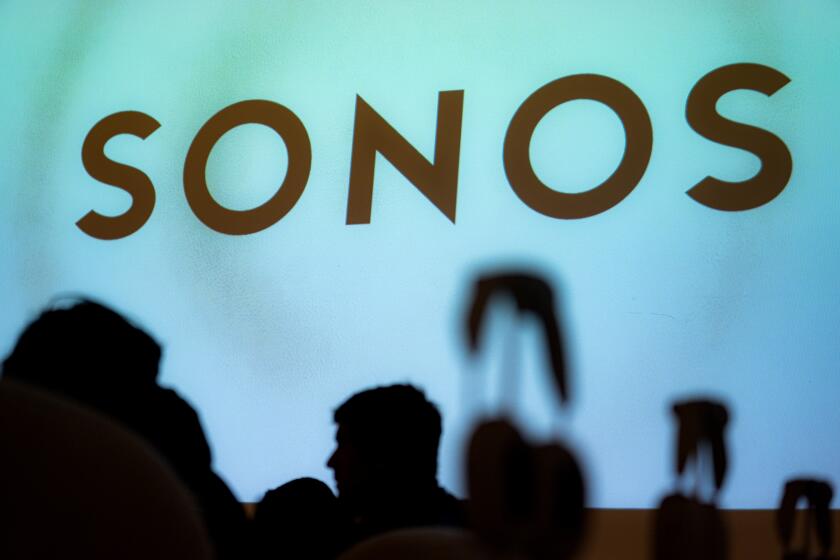Wall Street rallies on election day as economy remains solid

- Share via
NEW YORK — U.S. stocks rallied Tuesday as voters headed to the polls on the last day of the presidential election and as more data piled up showing the economy remains solid.
The Standard & Poor’s 500 rose 1.2% to pull closer to its record set last month. The Dow Jones industrial average climbed 1% while the Nasdaq composite gained 1.4%.
The market got a lift from a report showing growth accelerated last month for retailers, transportation companies and other businesses in U.S. service industries. That was despite economists’ expectations for a slowdown, and the Institute for Supply Management said it was the strongest growth in more than two years.
The report offered more hope that the U.S. economy will remain solid and avoid a long-feared recession after the worst inflation in generations.
Excitement about the artificial intelligence boom also helped lift the stock market, as it has for much of the last year. Software company Palantir Technologies jumped 23.5% after delivering bigger profit and revenue than analysts expected for the latest quarter. It’s an industry known for thinking and talking big. Chief Executive Alexander Karp said: “We absolutely eviscerated this quarter, driven by unrelenting AI demand that won’t slow down.”
It helped offset a 5.2% drop for NXP Semiconductors. The Dutch company suffered one of the largest losses in the S&P 500 after warning that weakness it saw in the industrial and other markets during the latest quarter is spreading to Europe and the Americas.
All told, the S&P 500 rose 70.07 points to 5,782.76. The Dow jumped 427.28 points to 42,221.88, and the Nasdaq composite advanced 259.19 points to 18,439.17.
The market’s main event Tuesday was the election, even if the result may not be known for days or weeks as officials count all the votes. Such uncertainty could upset markets, along with an upcoming meeting by the Federal Reserve on interest rates later this week. The widespread expectation is for the central bank to cut its main interest rate for a second straight time.
The broad U.S. stock market has historically tended to rise regardless of which party wins the White House, even if each party’s policies can help and hurt different industries’ profits.
Since 1945, the S&P 500 has risen in 73% of the years in which a Democrat was president and 70% of the years in which a Republican was the nation’s chief executive, according to Sam Stovall, chief investment strategist at CFRA.
The U.S. stock market has risen more in magnitude when Democrats have been president, in part because a loss under George W. Bush’s term hurt the Republicans’ average. Bush took over as the dot-com bubble was deflating and exited office when the 2008 global financial crisis and Great Recession were devastating markets.
Besides who will be president, other questions hanging over the market include whether the White House will be working with a unified Congress or one split by political parties, as well as whether the results will be contested.
The general hope among investors is often for split control of the U.S. government because that’s more likely to keep the status quo and avoid big changes that could drive the nation’s debt much, much higher.
As for a contested election, Wall Street has some precedent to look back to. In 2000, the S&P 500 dropped 5% in about five weeks after election day before Al Gore conceded to George W. Bush. That, though, also happened during the near-halving of the S&P 500 from March 2000 to October 2002 as the dot-com bubble deflated.
Four years ago, the S&P 500 rose the day after polls closed, even though a winner wasn’t yet clear. And it kept going higher after former President Trump refused to concede and challenged the results, creating plenty of uncertainty. A large part of that rally was due to excitement about the potential for a vaccine for COVID-19, which had just shut down the global economy.
The S&P 500 ended up rising 69.6% from election day 2020 through Monday, following President Biden’s win. It rallied to records as the U.S. economy bounced back from the COVID-19 pandemic and managed to avoid a recession despite a jump in inflation.
In the four years before that, the S&P 500 rose 57.5% from election day 2016 through election day 2020, in part because of cuts to tax rates signed by Trump.
Investors have already made moves in anticipation of a win by either Trump or Vice President Kamala Harris. But Paul Christopher, head of global investment strategy at Wells Fargo Investment Institute, suggests not getting caught up in such pre-election moves, or even those immediately after the polls close, “which we believe will face inevitable tempering, if not outright reversals, either before or after Inauguration Day.”
In the bond market, the yield on the 10-year Treasury initially rallied after Tuesday morning’s strong report on U.S services businesses but pared the gain later in the day. It slipped to 4.28% from 4.29% late Monday.
In stock markets abroad, indexes were mixed in Europe and Asia. The moves were mostly modest outside of jumps of 2.3% in Shanghai and 2.1% in Hong Kong.
Choe writes for the Associated Press. AP writers Matt Ott, Alex Veiga and Elaine Kurtenbach contributed to this report.
More to Read
Inside the business of entertainment
The Wide Shot brings you news, analysis and insights on everything from streaming wars to production — and what it all means for the future.
You may occasionally receive promotional content from the Los Angeles Times.










